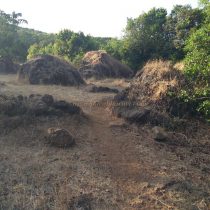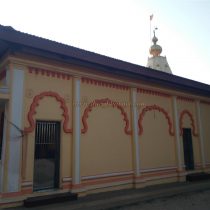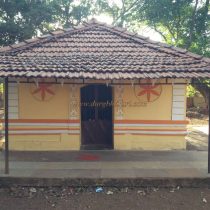NARAYANGAD
TYPE : HILL FORT
DISTRICT : SINDHUDURG
HEIGHT : 2380 FEET
GRADE : MEDIUM
Amboli, situated on the foothills of the Sahyadri in the Sindhudurg district, has been a place of cool air in the Sawantwadi Sansthan for a long time. There are some places to see the natural beauty of Sahyadri and one of them is Kavalesad Point. Many tourists visit this Kavalesad point but no one steps towards Narayangad which is on the opposite side. The main reason for this is that the people of the Narayangad area do not know anything about this fort. Not only that, except for a few old men in Gele village near the fort, even the young class does not know about this fort. Since there are numerous other paths on the main path to the fort and the remains of the fort are lost in the trees and bushes, it is necessary to have a guide to go to the fort. Amboli is a cool place 506 km from Mumbai via Kolhapur and 32 km from Sawantwadi.
...
On the way from Amboli to Kolhapur, Gele is a village near Narayangad at a distance of 8 km. On the Amboli-Belgaon road, 6 km from Amboli, a fork is constructed to reach Kavlesad Point and Gele village. After passing through this fork, the road on the right leads to Kavalesad Point and the road on the left leads to Gele village. A car can reach to Ravalnath temple in Gele village. If you want to stay in the village, you can stay in this temple. As there is no drinking water facility on the fort, you should go there with enough water. After reaching the back of the Ravalnath temple, you can reach the fort by taking a right turn. At one point on the right side of the road, there are water cisterns carved in the rock at some distance and the water in it is potable all year round but these cisterns are not visible from the sidewalk. On the left side of the road, there is a ruined temple of Lord Shiv. The remnants of this temple consist of Shivling and a Nandi. The locals call this place Lingi. The road leading from here goes through thick trees. There are some sculptures on the left side of this tree and the locals call this place Mhartal. From here we cross a slope and come to Narayangad pass. Narayangad is somewhat separated from the main range of the Sahyadri. On the way to the fort from Gele village, we reach the gorge between Narayangad and the Sahyadri range. We reach the fort in five minutes by climbing the slope on the left side. The gate of the fort and the adjoining ramparts have been destroyed today. Upon entering the fort, there is a stone basin in front and there are 2-3 quadrangle structures on the backside of this basin. If you climb the tall rock here, you can see the entire area of the fort. There are not many remains on the fort and the ones which are there are hidden in the bushes. There is a place of Goddess Sateri on the fort but the idol has been taken to the village. A few carved stones are lying under a tree. Apart from this, there is a dry water pond on the fort. In some parts of the fort, the collapsed ramparts can be seen. Spread from south to north, the fort is 2330 feet above sea level. Far from the fort, Manohar-Mansantosh fort to the west, Kavalesad Point to the east and the Konkan area spread far and wide, and Parpoli Ghat. It takes 3 hours to return to Gele village after seeing the entire fort. Mahadevgad and Narayangad forts can be easily seen from Amboli in one day. Although there are many wharves to reach Konkan from the Sahyadri range, Ambaghat, Bavadaghat, Fondaghat, and Parpoli Ghats are the four important wharves. The Parpoli Ghats are characterized by the forts of Mahadevgad and Narayangad at the top and the fort of Manohar-Mansantoshgad at the base. The goods unloaded at the Konkan port used to go to the markets on the wharves through various routes. Narayangad fort was built between 1709 and 1738 by Anasaheb Fondsawant of Sawantwadi Sansthan to guard the Parpoli Ghat. tax collection center was present in this fort. During 1772-73, Jiwaji Vishram, the caretaker of Sawant, conquered Mahadevgad and Narayangad and also took possession of Rangana. After this, in January 1788, Karveerkar returned Narayangad to Sawant in 1793. According to a letter dated November 20, 1804, Sawant attacked and conquered Narayangad which was under the control of Karveerkar. In 1828, Fondsavant Tambulkar revolted against Sawant and took control of the fort, but he fled when the British army came to Sawant's aid. This fort, which was flourishing till 1832, became damp forever due to the economic condition of Sawant.
© Suresh Nimbalkar





